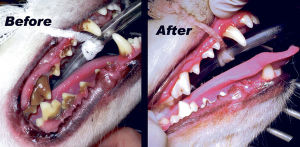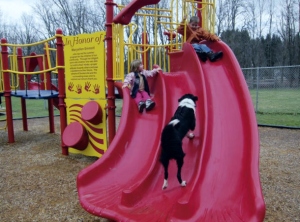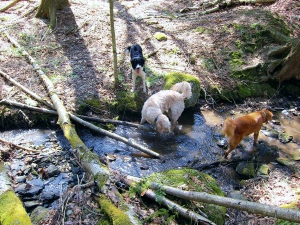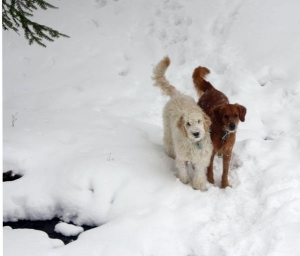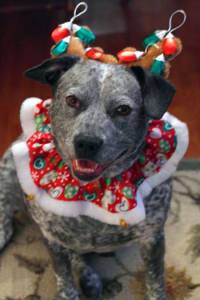The importance of veterinary care for our feline friends
By Dr. Rebekah Frost - OBSERVER Columnist
It’s a Monday morning. My family’s 15-year-old kitty Breezy is due for her annual blood work at the clinic. I head out to the garage to find one of our many pet carriers. Of course I can’t find one and my husband has already left for work. I’m already running behind for the morning! I finally grab one from the attic. I bring it downstairs and of course all the kitties go running. They know what the carrier means – a disruption in their normal routine and a trip to the veterinary office. They don’t like it – even when the vet is their own mom! I drag Breezy out from under the bed, and struggle to get her in the carrier; hind end first, while I am trying to tuck all four of her sprawling legs into the carrier. Finally we are off in the car. My entire 22 mile drive to work is disrupted by the constant yowling coming from the carrier! We get to work and she is fine; she has survived the trip. She does not appreciate her blood draw, but it is very important because in her older years she has started to drop in weight. Everything, however, turns out OK but she is happy to go back home at the end of the day.
My story is a common one I hear from many of my clients and just a few reasons why I don’t see these clients’ kitties! I see dogs on a routine basis; vaccines, yearly blood tests, and preventatives. But many times, I do not realize that these same clients have one or more cats in their households. A feline pet’s health is just as important as a canine pet’s!
Some other explanations from clients for bringing in these kitties:
1. My cat is strictly indoors; it doesn’t need vaccines.
2. My cat is strictly indoors, it won’t get fleas.
3. My cat hates coming to the vet and gets very stressed when we try to bring it.
4. I cannot catch my cat to bring it to the vet.
5. My cat gets sick in the car.
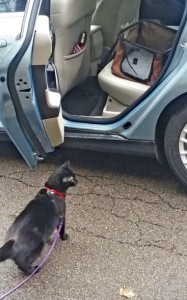
Dora mistrusts her cat carrier because she associates it with a trip to the veterinarian. OBSERVER Photo by Nicole Gugino
Indoor cats may be at just as much risk for picking up deadly viruses as a dog. Many of the respiratory viruses I vaccinate against can be spread by aerosolized secretions. In the warmer months, any stray cats wandering around the home may expose a pet cat to these respiratory viruses even just through an open window. More importantly, rabies is a public health concern because humans can contract the deadly virus through contact with a rabid animal. Rabies can be carried by dogs, cats, raccoons, skunks, coyotes, and bats. If bats live in and around your home, and if a bat has come into it, it’s possible your cat has been exposed to the rabies virus. It is very important for your health and your cat’s health that the cat receives a rabies vaccine every three years. New York State law provides that if your cat happens to bite a person and is not vaccinated, it can be put to sleep.
Even if your cat is indoors, it can still pick up fleas and intestinal parasites from fleas. A pet dog may bring in the fleas, or they may hitch a ride on human shoes or pant legs. Once a female flea receives a blood meal from the pet, she can lay thousands of eggs which can all hatch and turn into a flea infestation even on an indoor cat! I still recommend monthly prevention against fleas because fleas can make a pet anemic, cause severe secondary skin infections and skin allergies, and can carry intestinal parasites.
Many pets hate coming to the vet. I assure you we will do everything in our power to make your pet more comfortable when they come to visit. We will give your pet attention and treats to try to put them at ease. If the pet is extremely stressed we may give it a sedative to make the experience more relaxing for the animal, you, and us!
I have also recommended for some pet owners to desensitize their cats to the experience. This might include putting your cat’s carrier in a common area with treats and food so they become comfortable with it and don’t always associate the crate with a trip to the veterinarian. I also recommend bringing cats in for a visit for petting and treats at any time so they don’t always associate the veterinary office with injections and examinations. Ask if your veterinarian carries a product called Feliway. This comes in a variety of forms sprays, wipes, and wall plug-ins and contains natural cat pheromones to help put the cat at ease.
If you have difficulty catching your cat, put it in a smaller area such as a bedroom a day or two before its appointment. Move its food, litter box, and the crate to the smaller area as well. It may be easier to catch the cat before its appointment instead of chasing it all over the house an hour before its visit!
If your cat gets sick in the car, pick up its food the night before its appointment. This way the cat won’t have a stomach full of food. We are also very good at cleaning out the carrier for you in case it still gets sick!
It is very important for a cat to have a physical examination by a veterinarian at least once yearly. Many underlying conditions may go unnoticed. I might just pick up on a slight drop in weight, which may be normal for your cat, or may be a significant finding requiring further testing. Older cats in particular are prone to developing kidney disease, heart disease, or thyroid disease. A veterinarian might just feel a slight enlargement in the thyroid gland. If these conditions are caught early, the cat can receive proper treatment and live a longer happier life! Call us today to schedule an appointment for your feline friends.

